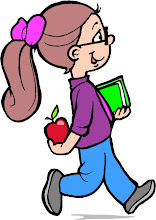- We are continuing to memorize 1 Corinthians 13.
- In 24 Ways we are on #2, Reading the Bible and Praying everyday with an open heart. We have discussed what an "open heart" means, and I am able to pull examples from our memory verses, so that makes it more meaningful.
- We finished reading Genesis.
- We completed the Friendship book and are working on making a board game from what we learned.
- In lesson seven of Life Lessons from P & K, we were learning about godly wisdom. The book suggested making a paper crown, but K. has so many crowns that I knew it wouldn't be special. I looked online for crown crafts and came up with this one. The beads are supposed to be on safety pins, and then hung from a larger safety pin to make a pin to wear, but I decided to just use things I had on hand, so we came up with this craft.
We put the beads on floral wire, and wrapped
the extra wire around a popsicle stick.
I used another piece of wire to make a hanger.
I had wooden alphabet letters (just about every letter
except W, so we turned an extra M upside down)
and K. painted them and we glued them on a tongue
depressor, and then glued the stick with
"WISDOM" onto the popsicle stick.
- We finished reading Joel this week and played some games to review 1 Corinthians 13.






